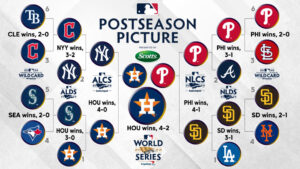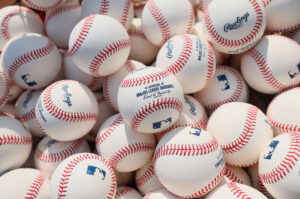The Major League Baseball final regular-season standings used to, for a very long time, largely dictate the order of the Draught the following year. Simply choose the standings in reverse order, and that is how teams would choose
Starting last year, thanks to the latest Collective Bargaining Agreement, that script has changed. Now, the non-playoff teams are entered into a lottery for the top six picks in the Draft.
The lottery will take place at the Winter Meetings in Nashville, Tenn., on Tuesday, Dec. 5.
This year, 17 of the 18 non-playoff teams are eligible for the lottery, listed here in reverse order of standings with each team’s winning percentage in parentheses.

1. Athletics (.309), 18.3 pct
2. Royals (.346), 18.3
3. Rockies (.364), 18.3
4. White Sox (.377), 14.7
5. Nationals (.438), 0.0 (ineligible for lottery pick)
6. Cardinals (.438), 8.3
7. Angels (.451), 6.1
8. Mets (.463), 4.3
9. Pirates (.469) 3.0
10. Guardians (.469), 2.0
11. Tigers (.481), 1.6
12. Red Sox (.481), 1.2
13. Giants (.488), 1.0
14. Reds (.506), 0.9
15. Padres (.506), 0.7
16. Yankees (.506), 0.6
17. Cubs (.512), 0.4
18. Mariners (.543), 0.2
Teams that are “payor clubs”—clubs who provide revenue sharing funds rather than receiving them—are prohibited from being chosen in successive lotteries, which is why Washington is not eligible to play in this year’s lottery. Even though the Nationals had the fifth-worst record in baseball in 2023, their chances of being selected again are zero because they were chosen last year. The Nationals might not get a better pick than the tenth overall. They would only choose less than that in the unlikely event if none of the four teams with the worst record were chosen in the lottery, which has a less than.03% chance of happening.
With that exception, teams that are not selected in the top six will choose their seventh through eighth picks in reverse order of the rankings.
The Padres, Yankees, and Mets are in the lottery because they did not make the playoffs, and they will keep their pick if they land in the top six. If not, the surcharge tax level for each of the three players’ 2023 player payrolls would be exceeded, moving their selection back ten spots in the Draught. In the event that one of these clubs wins a lottery pick, the team with the second-highest pick would drop ten slots.
The order of the postseason teams are determined by when they get eliminated and their revenue-sharing status. Those 12 teams will choose in the following order: Wild Card Series losers, Division Series losers, Championship Series losers, World Series loser, World Series winner. Within each of those groups, clubs will be sorted by revenue-sharing status, with payee clubs selecting before non-payee clubs. If two or more clubs have identical winning percentages in the immediately preceding championship season, the selection order of those clubs will be determined by winning percentage in the next prior championship season, with any remaining ties resolved by the tied clubs’ respective championship season winning percentages in each preceding year, until the tie is broken.
The order of the draught for the 10 other playoff clubs is now known, with only the Rangers and D-backs remaining in action.
19. Marlins (.519)
20. Brewers (.568)
21. Rays (.611)
22. Blue Jays (.549)
23. Twins (.537)
24. Orioles (.623)
25. Dodgers (.617)
26. Braves (.642)
27. Astros (.556)
28. Phillies (.556)
Last year, in the Draft Lottery, the Pirates won the first pick, enabling them to take Paul Skenes. They were tied with the Nationals and A’s with the best odds to win. The Nats ended up with the second pick, while the A’s ended up picking sixth. The Twins, who were 13th in terms of lottery odds to win the No. 1 pick, vaulted up to No. 5.
After the first round, the lottery results won’t affect picks 1-18, which will be in reverse order of winning percentage.
Leave a Reply